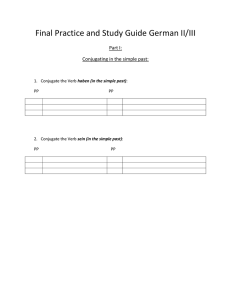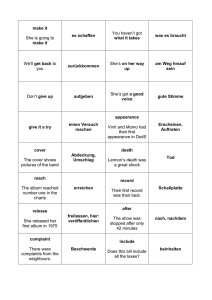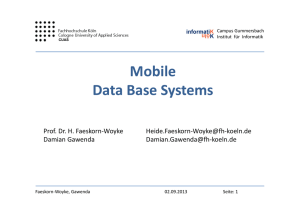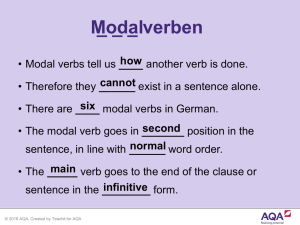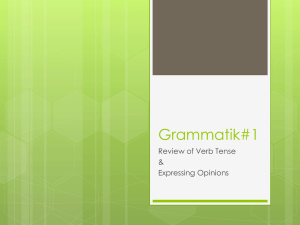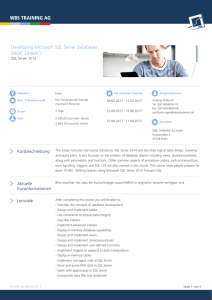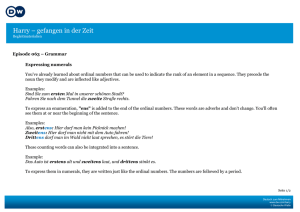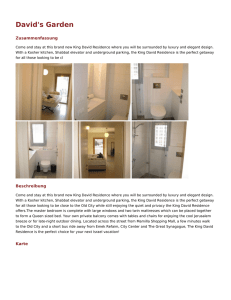File
Werbung
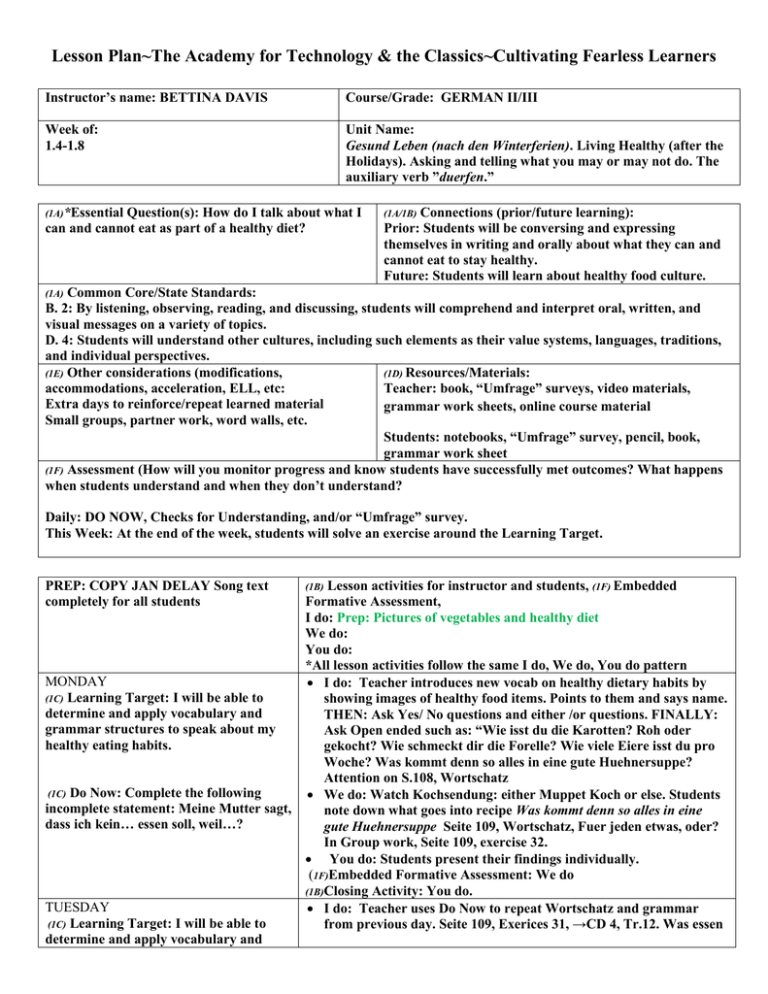
Lesson Plan~The Academy for Technology & the Classics~Cultivating Fearless Learners Instructor’s name: BETTINA DAVIS Course/Grade: GERMAN II/III Week of: 1.4-1.8 Unit Name: Gesund Leben (nach den Winterferien). Living Healthy (after the Holidays). Asking and telling what you may or may not do. The auxiliary verb ”duerfen.” (1A)*Essential Question(s): How do I talk about what I can and cannot eat as part of a healthy diet? Connections (prior/future learning): Prior: Students will be conversing and expressing themselves in writing and orally about what they can and cannot eat to stay healthy. Future: Students will learn about healthy food culture. (1A/1B) Common Core/State Standards: B. 2: By listening, observing, reading, and discussing, students will comprehend and interpret oral, written, and visual messages on a variety of topics. D. 4: Students will understand other cultures, including such elements as their value systems, languages, traditions, and individual perspectives. (1E) Other considerations (modifications, (1D) Resources/Materials: accommodations, acceleration, ELL, etc: Teacher: book, “Umfrage” surveys, video materials, Extra days to reinforce/repeat learned material grammar work sheets, online course material Small groups, partner work, word walls, etc. Students: notebooks, “Umfrage” survey, pencil, book, grammar work sheet (1F) Assessment (How will you monitor progress and know students have successfully met outcomes? What happens when students understand and when they don’t understand? (1A) Daily: DO NOW, Checks for Understanding, and/or “Umfrage” survey. This Week: At the end of the week, students will solve an exercise around the Learning Target. PREP: COPY JAN DELAY Song text completely for all students Lesson activities for instructor and students, (1F) Embedded Formative Assessment, I do: Prep: Pictures of vegetables and healthy diet We do: You do: *All lesson activities follow the same I do, We do, You do pattern MONDAY I do: Teacher introduces new vocab on healthy dietary habits by (1C) Learning Target: I will be able to showing images of healthy food items. Points to them and says name. determine and apply vocabulary and THEN: Ask Yes/ No questions and either /or questions. FINALLY: grammar structures to speak about my Ask Open ended such as: “Wie isst du die Karotten? Roh oder healthy eating habits. gekocht? Wie schmeckt dir die Forelle? Wie viele Eiere isst du pro Woche? Was kommt denn so alles in eine gute Huehnersuppe? Attention on S.108, Wortschatz (1C) Do Now: Complete the following We do: Watch Kochsendung: either Muppet Koch or else. Students incomplete statement: Meine Mutter sagt, note down what goes into recipe Was kommt denn so alles in eine dass ich kein… essen soll, weil…? gute Huehnersuppe Seite 109, Wortschatz, Fuer jeden etwas, oder? In Group work, Seite 109, exercise 32. You do: Students present their findings individually. (1F)Embedded Formative Assessment: We do (1B)Closing Activity: You do. TUESDAY I do: Teacher uses Do Now to repeat Wortschatz and grammar (1C) Learning Target: I will be able to from previous day. Seite 109, Exerices 31, →CD 4, Tr.12. Was essen determine and apply vocabulary and (1B) grammar structures to speak about my healthy eating habits. (1C) Do Now: What do you eat oft/manchmal/nie? WEDNESDAY (1C) Learning Target: I will be able to express orally and in writing what I am able to eat or not, using kein/keine. Do Now: Write down what you can’t eat due to health concerns. (1C) sie gern, was nicht? Audio comprehension exercise individually. Teacher introduces: Wortschatz, Seite 110 Prep: Bring candy bars of sorts & Carrot and Obst: Die Schokolade will ich nicht essen, denn sie hat zu viel Fett, zu viel Zucker,zyu viele Kalorien. Check the label: Lass’ mal sehen…500 Kalorien! Hold up KArotte: Was hat weniger Kalorien, die Karotte, oder die Schokolade? Continue w/ nuts: Ich darf die Nuesse nicht essen, weil ich allergisch bin. Practice w/ students. We do: Seite 110.Wortschatz. With learned Wortschatz and vocabulary, students “SUCH DIR EINEN PARTNER &fragt euch gegenseitig, was ihr essen duerft und was nicht.”Come up with individual lists of at least 5 items. You do: Students share aloud individually. (1F)Embedded Formative Assessment: We do. Teacher collects for grade. (1B)Closing Activity: you do. I do: Teacher introduces kein/keine:Divide class into 2 equal Mannschaften. Toss a coin to decide which goes 1. Ask a member of that team a question such as „Magst/Isst du Aprikosen?“ The student should use KEIN/KEINE in answer. Ih mag keine Aprokosen (preteach). Go down the team, asking similar questions until one memebr answers wronlgy. Switch to other team, do same. Continue always w/ the student who answered incorrectly. 1. Team who answers totally correctly wins. We do: Seite 110 Eine Wenig Grammatik & SSMD. Practice: →CD 4, Tr.13. Uebung in groups: Seite 116, 8. You do: Group discussion on solutions on Seite 116, 8. (1F)Embedded Formative Assessment: We do. Activity: You do. (1F) I do: Teacher introduces the verb “duerfen,’ explaining first the difference btw. DUERFEN & KOENNEN: “duerfen” implies permission, “koennen” implies ability. Using examples in SSMA, Seite 110, Provides practice by asking: “Was darf ein Diabetiker essen/ nicht essen? Was darf ein Vegetarier essen /nicht essen? Jim ist allergisch auf Orangen. Was darf er nicht essen? We do: Prep Index Cards: Pronouns, Nouns. Distribute index cards in teams of two. Team members create as many “duerfen/nicht duerfen” sentences as possible with cards. Winner: most sentences. In groups of 4 and using verb constructions duerfen, nicht duerfen You do: Presenting sentences. (1B)Closing THURSDAY (1C) Learning Target: I will be able to express orally and in writing what I am able to eat, using “duerfen” und “nicht “duerfen.” Do Now: Write down 3 things you eat and 3 things you don’t eat using kein/keine (1C) (1F)Embedded Formative Assessment: We do Activity: You do I do: Teacher repeats duerfen and conjugates the verb duerfen w/ help of students on board. We do: Watch Werbespot on du Darfst. In pairs, students draw inferences on what this brand name implies. Seite 116, Aufgabe 9, practice individually. Seite 117, practice in pairs. You do: Seite 119, Essay writing exercise, individually. Teacher leads into and clarifies what to do but students do alone and submit next Monday. (1B)Closing FRIDAY (1C) Learning Target: I will be able to conjugate the verb “duerfen.” Do Now: Write down 3 things you eat and 3 things you don’t eat using duerfen and nicht/duerfen. (1C) (1F)Embedded Formative Assessment: Seite 116 for grade (1B)Closing Activity: You do/ sharing aloud how far we have come so far. Conjugate the verb duerfen orally as whole group. *Refers to NMTEACH Rubric: 1A-Demonstrating knowledge of content 1B-Designing coherent instruction 1C-Setting Instructional outcomes 1D-Demonstrating knowledge of resources 1E-Demonstrating knowledge of students Formative Assessment includes, but is not limited to: Exit tickets, white board response, consensagrams, red/green cards, formal or informal student conferences, sticky note assessment.
